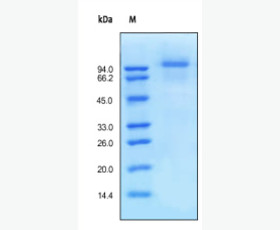Recombinant Human Ubiquitin-Conjugating Enzyme E2 Variant 2/UBE2V2/DDVIT1
| Product name: | Recombinant Human Ubiquitin-Conjugating Enzyme E2 Variant 2/UBE2V2/DDVIT1 |
| Source: | E. coli |
| Purity: | Greater than 95% as determined by reducing SDS-PAGE. |
| Buffer Formulation: | Supplied as a 0.2 μm filtered solution of 50mm HEPES,150mM NaCl, pH 7.0. |
| Applications: | Applications:SDS-PAGE; WB; ELISA; IP. |
| Storage: | Avoid repeated freeze/thaw cycles. Store at 2-8 oC for one month. Aliquot and store at -80 oC for 12 months. |
| UOM: | 100ug/50ug/200ug/1mg/1g |
| Source | E. coli |
| Description | Recombinant Human Ubiquitin-Conjugating Enzyme E2 Variant 2 is produced by our E.coli expression system and the target gene encoding Met1-Asn145 is expressed with a 6His tag at the N-terminus. |
| Names | Ubiquitin-Conjugating Enzyme E2 Variant 2, DDVit 1, Enterocyte Differentiation-Associated Factor 1, EDAF-1, Enterocyte Differentiation-Promoting Factor 1, EDPF-1, MMS2 Homolog, Vitamin D3-Inducible Protein, UBE2V2, MMS2, UEV2 |
| Accession # | Q15819 |
| Formulation | Supplied as a 0.2 μm filtered solution of 50mm HEPES,150mM NaCl, pH 7.0. |
| Shipping |
The product is shipped on dry ice/ice packs. |
| Storage |
Store at < -20°C, stable for 6 months after receipt. Please minimize freeze-thaw cycles. |
| Purity |
Greater than 95% as determined by reducing SDS-PAGE. |
| Endotoxin | Less than 0.1 ng/µg (1 IEU/µg) as determined by LAL test. |
| Amino Acid Sequence |
MGSSHHHHHHSSGLVPRGSHMAVSTGVKVPRNFRLLEELEEGQKGVGDGTVSWGLEDDEDMTLTR WTGMIIGPPRTNYENRIYSLKVECGPKYPEAPPSVRFVTKINMNGINNSSGMVDARSIPVLAKWQ NSYSIKVVLQELRRLMMSKENMKLPQPPEGQTYNN
|
| Background | Ubiquitin-Conjugating Enzyme E2 Variant 2 (UBE2V2) is an enzyme that belongs to the ubiquitin-conjugating enzyme family. UBE2V2 can be detected in the placenta, colon, liver, and skin. It forms a heterodimer with UBE2N. The UBE2V2/UBE2N heterodimer catalyzes the synthesis of non-canonical poly-ubiquitin chains and which leads to protein degradation by the proteasome. UBE2V2 mediates transcriptional activation of target genes. It plays a role in the control of progress through the cell cycle and differentiation. It also plays a role in the error-free DNA repair pathway and contributes to the survival of cells after DNA damage. |














